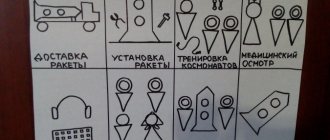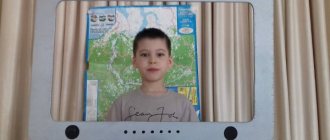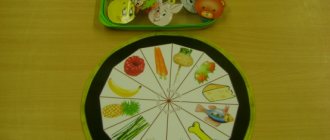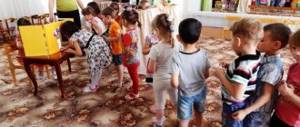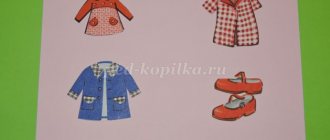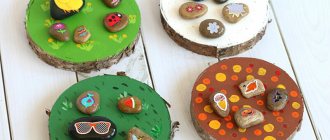Thematic selection of gaming material on the theme of the folk tale “Teremok”
Goals:
Continue to teach children to listen carefully and watch a fairy tale, emotionally perceiving its content. Form stable ideas about the color, shape, quantity and size of objects. Continue to teach children to navigate in space, to understand the meaning of the concepts “up”, “down”, “next to”, “pa”, “under”, “above”. Improve the ability to finger paint, stick, and sculpt. Develop auditory and visual perception, thinking, sense of rhythm, fine and gross motor skills.
Equipment:
Figures for tabletop theater for the fairy tale “Teremok”. Colored pictures of animals depicted on a strip of paper divided by vertical lines, scissors. Volumetric details of building material. A background picture with an image of a mansion, two stripes-paths of different lengths, color silhouette pictures of mice. Boxes with round and square holes, cubes and balls of the appropriate size. Water lily leaves cut from green oilcloth, a bench, a tunnel. Details of the “frog” applique, yellow plasticine, pumpkin seeds, glue. A sheet with large and small circles pasted on, large and small colored silhouette pictures of cabbage. Orange finger paints, fox coloring. Circles-plates cut out of white paper, multi-colored pencils. Buttons of different colors in two sizes, a picture of beads (circles-beads correspond to the color and size of the buttons). Metallophones. Background picture with a picture of a Christmas tree and a den. Silhouette color pictures: sun, cloud, mushrooms, bear. White paper circles, brown and yellow pencils. Sheet diagram, multi-colored squares made of thick cardboard. Audio recordings: “Dance” from the cartoon “Teremok”, “Song of the Frog”.
Progress of the lesson:
Demonstration of the tabletop theater "Teremok"
There is a tower in a field, not low, not high.
A small mouse runs past. She saw the tower, stopped and asked:
- Who lives in the little house? Who lives in a low place? Nobody responds. The mouse entered the little mansion and began to live there. A frog-frog jumped up to the little house and asked: “Who lives in the little house?” - I, little mouse! And who are you? - And I am a frog. - Come live with me!
The frog jumped into the mansion and the two of them began to live together. A runaway bunny runs past. He stopped and asked:
- Who lives in the little house? - I, little mouse! - I, frog-frog! - And who are you? - And I’m a runaway bunny. - Come live with us!
The hare hops into the tower! The three of them began to live together. A little fox-sister walks by. She knocked on the window and asked:
-Who lives in the little house? - I, little mouse. - I, frog-frog. - Me, the runaway bunny. - And who are you? - And I am a fox-sister. - Come live with us!
The fox climbed into the mansion. The four of them began to live together. A gray barrel top came running, looked in the door and asked:
- Who lives in the little house? - I, little mouse. - Me, the runaway bunny. - I, little fox-sister. - And who are you? - And I’m a gray barrel top. - Come live with us!
The wolf climbed into the mansion. The five of them began to live together. Here they live in a little house, sing songs. Suddenly a clubfoot bear walks past. The bear saw the tower, heard the songs, stopped and roared at the top of his lungs:
- Who lives in the little house? - I, little mouse. - I, frog-frog. - Me, the runaway bunny. - I, little fox-sister. - I, the top-gray barrel. - And who are you? - And I’m a clumsy bear. - Come live with us!
The bear climbed into the tower. He climbed and climbed and climbed and climbed and couldn’t get in and said:
- I’d rather live on your roof. - Yes, you will crush us! - No, I won’t crush it. - Well, then climb up!
The bear climbed onto the roof and just sat down - bang-bang! – the tower cracked and the whole thing fell apart. We barely had time to jump out of it: a small mouse, a frog, a runaway bunny, a little fox-sister, a gray barrel top - all safe and sound. They began to carry logs, saw boards, and build a new mansion. Built better than before!
Cutting with scissors “Inhabitants of the Teremka”
Children use scissors to cut a strip of paper with images of fairy tale characters along vertical lines.
Didactic game “Who lives in the little house?”
Children show a picture of the animal that the teacher names.
Who lives in the little house? Does anyone live in a low place? - I, little mouse. - I, frog-frog. - Me, the runaway bunny. - I, little fox-sister. - I, the top-gray barrel. - I'm a clumsy bear. What does the frog say? Kwa-kwa. How does a wolf howl? Oooh. How does the mouse squeak? Peep-pee-pee. How does a bear roar? Y-s-s.
Construction "Building a tower"
Children build a mansion from building material according to the teacher’s model.
And now the inhabitants of the tower want to play with you.
GuidelinesIn Russian pedagogical science there is an ambiguous attitude towards fairy tales. Some believe that fairy tales “clog” children's consciousness with useless information. We adhere to the opposite point of view: a fairy tale is a complex and important element of culture for children's development. Folk tales not only enrich a child’s imagination, but also contribute to the development of creative activity. However, in order to promote effective child development, you need to be able to introduce your child to fairy tales. It is not enough to simply read a story, ask some questions and move on to the next one. It is important to dwell in more detail on the content of the fairy tale,, if possible, act it out and model key fragments.
For each age, we can select such fairy tales, the mastery of which will successfully develop children's thinking, creativity, imagination and speech. Thus, children of primary and secondary preschool age can be offered the fairy tale “Teremok”, which allows them to acquaint them with the action of seriation (arranging objects in ascending and descending order of some attribute). This action is one of the first mental actions developed in preschool age. With its help, the child can observe various changes occurring in the world around him. For example, based on the action of seriation, a child can understand how the temperature changes during the day: it is cool in the morning, warm in the afternoon, and in the evening it becomes cool again.
The action of seriation is not inherently visual, so it is not easy for children of primary preschool age to master it. In order to demonstrate to a child the presence of serial relationships in a fairy tale, it is necessary to model the work, that is, convey its content using clearly presented relationships between fairly simple objects.
Familiarization with the fairy tale “Teremok” is carried out over 8 lessons.
Lesson 1. Read a fairy tale and answer questions
Answering questions is an important point in familiarizing children with the content of a fairy tale. Thanks to skillfully posed questions, the adult has the opportunity to focus the child’s attention on certain moments of the fairy tale, which otherwise might simply be missed.
The teacher tells the children: “Today we will get acquainted with the fairy tale “Teremok.” This is a very interesting fairy tale. Do you want to listen to her?
As the story progresses, the adult shows the corresponding plot pictures. After reading a fairy tale, the teacher asks questions about its content (each question is accompanied by a picture showing the corresponding fragment of the fairy tale).
- Who was the first to live in a mansion? (Mouse.)
-What kind of mouse was it? (Small.) Show me. (Children squat down.)
- Who then galloped to the tower?
- Who was already living in the little house when the frog frog arrived? (Mouse.)
- Who is bigger: a mouse or a frog? (Frog.)
Similar questions are asked about the other characters.
- Who was the last to approach the tower? (Bear.)
- Why didn’t the animals want to let the bear into the mansion? (The bear is very big, it is larger than the tower, it cannot fit in it.)
- Why did the tower collapse? (The bear is very big. He is larger than a tower.)
During this lesson, children should learn to understand the sequence in which the characters of the fairy tale appeared (who is the smallest and who is the largest), that the tower cannot accommodate a bear, which is much larger than the tower.
Lesson 2. Arranging pictures
During this lesson, children learn to arrange pictures in accordance with the plot of the fairy tale.
The teacher shows the children pictures that depict fragments of the fairy tale and says: “Now I will read the fairy tale, and you will show the pictures.” As they read, children show corresponding pictures. If the child makes mistakes, the adult stops reading, discusses the content of the episode with him and shows a suitable picture.
Then the teacher asks the children to lay out the pictures in accordance with the sequence of the plot. After the children complete the task, the adult reads the fairy tale again, and the preschoolers again, as they read, point to the corresponding pictures (and show them to the adult).
For an adult, reading a fairy tale repeatedly may seem boring and unnecessary. However, in order for children to retain the entire sequence of events in their memory, it is necessary to reproduce the plot of the work many times. Typically, children willingly listen to a fairy tale several times and are happy to choose pictures that correspond to the plot, since completing this feasible task makes them proud of the successful action.
At the end of the lesson, the teacher offers the following game. He deliberately misplaces one of the pictures that reflects the sequence of the plot, and asks the children to find the picture that is out of place. You can then make the game more difficult by removing one of the pictures and asking the children to guess which picture is missing. Such tasks teach children to understand the sequence of plot development and arrange characters in ascending or descending order of any characteristic.
Lesson 3. Replacing fairy tale characters
In this lesson, children practice their ability to replace fairy tale characters with the help of substitute objects.
The adult takes cards depicting the characters of the fairy tale and the tower, shows them to the children and asks them to pay attention to the fact that the cards differ in size.
Next, the adult invites the children to play a guessing game. He turns the cards face down and asks the children to guess which card shows the tower. After the child shows the desired card, the adult asks: “How did you guess that this was a teremok?” If the child cannot answer the question, the teacher draws his attention to the fact that the picture showing the tower is wider than the other cards. Then the adult changes the location of the card with the tower among other cards and again offers to guess where it is.
Next, the teacher asks the children to find a card depicting a mouse. An adult offers this task to children several times to make sure that they are able to correctly find a character based on its distinctive feature (smallest size).
Particular attention should be paid to the picture with the image of a bear: this is the only card that is higher than the card with the image of the tower.
If during this lesson the children do not master the ability to replace a fairy tale character with a visual model, the lesson should be repeated.
Lesson 4. Modeling a fairy tale
In this lesson, children learn to build and “read” simple fairy tale models, which is a necessary condition for the successful development of children's thinking.
An adult places a brown rectangle and seven yellow stripes of different lengths in front of the children and says: “Let's try to remember the fairy tale using these figures. What do you think a rectangle could mean in a fairy tale? (If children have difficulty, an adult helps them find the correct answer: “Teremok.”) Which strip is the smallest? Who is the biggest in the fairy tale? (Bear.) What stripe can we designate a bear?” The teacher places the longest strip vertically next to the brown rectangle. An adult helps children identify all the characters in the fairy tale using strips of appropriate length. He once again draws attention to the fact that the strip representing the bear is higher than the rectangle representing the tower.
The next stage of this lesson is related to modeling fragments of a fairy tale: an adult shows the children a picture depicting a fragment of the work and asks them to build its model. (In this case, the animals that have entered the house should be to the left of it, and those that have not yet entered the house should be to the right.)
The last fragment of the fairy tale is modeled as follows: the largest strip is placed next to the brown rectangle, and the remaining strips are located at some distance from the rectangle.
After the children have built the appropriate model, the teacher invites them to reproduce the content of this fragment of the fairy tale (answer the question about what is depicted on the model).
At the end of the lesson, the teacher invites the children to play the following game. He shows them some model, for example, a brown rectangle, to the left of which there are three strips of successively increasing in length, and to the right - one strip (above the stripes located on the left) and asks to show a picture depicting the corresponding fragment of a fairy tale.
Lesson 5. Acting out a fairy tale
In this lesson, children learn to dramatize the actions of fairy tale characters, which helps develop their imagination.
The adult tells the children: “I will tell a fairy tale, and you will portray its heroes.”
The teacher starts reading a fairy tale: “A little mouse was walking. I saw a tower in the field. I knocked." The adult asks the child to show how the mouse knocks (quietly) and how it talks (in a very thin voice).
An adult reads the following fragment and invites the children to depict the actions of the characters. He draws children's attention to the fact that all the characters behave differently (the frog knocks a little louder and speaks in a rougher voice, the bear speaks in the loudest and roughest voice and knocks loudest). It is desirable that when acting out a fairy tale, children reproduce the general behavior of the characters, using expressive movements for this: the mouse is small, timid; wolf - strong; bear - clumsy, etc.
Lesson 6. Telling fragments of a fairy tale
During the lesson, children's ability to retell a fairy tale according to its model is developed, which contributes to the development of creativity in preschoolers.
The teacher models a fragment of a fairy tale and asks the children to tell what is depicted in the model. If the children have difficulty, he asks what each of the elements means.
It is best to start the lesson with a model consisting of a brown rectangle and the smallest strip to the right of it. This model corresponds to the beginning of the fairy tale, when the mouse saw the little house.
The next model can be represented by a brown rectangle, to the left of which is the smallest stripe, and to the right is a larger stripe. (A frog jumped up to the mouse, which already lives in the little house.)
The main thing is that when retelling a fairy tale, children name its characters. If necessary, an adult should help children.
When performing this task, you should take into account the children’s speech abilities (they cannot formulate a sentence, they can only complete it), and structure the lesson in such a way that they do not experience great difficulties.
Lesson 7. Telling the whole tale
In this lesson, the teacher continues to practice children’s ability to retell a fairy tale based on its model.
The teacher sequentially shows the stripes to the children and asks them to name the characters they replace.
Then the adult invites the children to tell a fairy tale: “I will lay out the figures, and you will help me tell the fairy tale.” The teacher places a brown rectangle, to the right of it he places the smallest strip and says: “There was a little mouse walking. I saw a tower in the field. I knocked...” (Pauses, and the child continues: “Knock-knock, who lives in the mansion?”)
The adult puts a small strip to the left of the brown rectangle and takes out a larger strip: “Jumped... (the frog).” And so on.
Then the teacher invites the children to independently lay out a model of the fairy tale and retell the work based on it (if necessary, an adult helps the children). As a result, children develop a holistic idea of both the content of a fairy tale and its structure; they are able to move from analyzing the structure to filling it with content and, conversely, from content to structure.
Lesson 8. Acting out a fairy tale
In this lesson, children who have already mastered retelling a fairy tale according to its model are asked by the teacher to choose the role of one of the characters and act out the work. To indicate the role, children receive medallions with images of the corresponding characters (medallions are made from round pictures to which ribbons are tied).
To depict a mansion, you can use a stool (then the characters who are inside the mansion will be located on one side of the stool, and the character who approached the mansion will be located on the other). At the end of the story, the child playing the role of a bear may simply knock over the chair.
The adult who plays the role of presenter and reads the text of the fairy tale must monitor the order in which the heroes appear. It is likely that some roles will seem more attractive to children and others less so, so if possible, the fairy tale should be acted out several times so that the children can change roles.
At home, it is not necessary to act out the entire fairy tale; you can limit yourself to some fragment of it. In this case, the child is offered the role of only one character.
As a result of this lesson, children’s ability to apply the action of seriation within the framework of specific content is consolidated. And following the role (and, consequently, the rules that it defines) leads to the development of voluntariness as an important direction in the development of the child’s personality.
Little mouse
Didactic game “Paths to the tower”
And different paths lead to the tower. How many tracks? Two. Same tracks? Different paths - one long and the other short. The mouse is confused, which path should it take to get to the house faster, the long path or the short one? Guys, what do you think? Yes, guys, that’s right, it’s faster for a mouse to run along a short path to the house, and now we need to correctly show it where the short path is. Move your mouse along the short path.
Didactic exercise “Hide in a box”
Children are asked to hide cubes and balls in the box by inserting them into holes of suitable shape.
Visual and didactic aid “Teremok”
Author:
Pavlova Tatyana Gennadievna,
teacher speech therapist,
second qualification category
MBDOU d/s general developmental type "Northern Lights"
Surgut district, Nizhnesortymsky village
The correctional and developmental environment in the speech therapy room plays an important role in the speech and mental development of children with speech disorders. Currently, on the product market you can purchase a variety of games and aids for the development of children's speech. In my practice, I actively use manuals made by myself. One of these aids is the visual and didactic game “Teremok”.
It is made of cardboard, in the center there is an image of a little house, with paths leading to it from the characters of the fairy tale. They are made from different materials: woolen threads, foam rubber, beans, sandpaper, buckwheat and pasta. The manual is portable, which allows it to be used not only in a speech therapy room, but also in kindergarten groups; it is multifunctional and can be manufactured.
This didactic game is intended for preschool children with speech disorders. It can be used for both individual and subgroup work.
The goal that I pursued in making this didactic game is the development of speech, the consolidation of speech skills acquired in speech therapy classes, as well as a means of stimulation for classes. It was tested in speech therapy practice and showed good results; it has a general developmental and correctional effect.
The game allows you to solve a number of pressing problems facing the teacher-speech therapist at the speech center:
-development of oculomotor function, prevention of visual disorders;
-automation of isolated sounds in speech;
-development of coherent speech;
-sensory development and finger massage;
1) Development of oculomotor function, prevention of visual disorders:
The tasks are completed in classes related to visual load. The poster is placed on the wall above the child's eye level. At the preparatory stage, it is necessary to introduce children to the didactic game. The teacher invites the child (children) to remember the fairy tale, tell it independently or with the help of a speech therapist.
Description of the game: “Guys, let’s help our heroes get to the tower, guide them with our eyes. Who was the first to find the tower? That's right, Squeaky Mosquito. We follow him with our eyes to the tower. Look in which direction it flies, performs circular movements, flies straight, descends, and now it has reached the tower. Who found the tower next?
So we accompany each hero to the tower. The teacher slowly moves the pointer along the lines and comments on his actions. Invites children to follow the pointer with their eyes. At the next stage, the child himself leads the pointer along the “paths” and comments on his actions.
The teacher monitors the accuracy of the exercise, helps to correctly pronounce the directions of movements and their changes, and only then the child independently, without a pointer, follows the “paths” with his eyes.
Thus, the child develops oculomotor functions and relieves visual tension.
2) Automation of isolated sounds in speech:
Description of the game: “Guys, our mosquito flies to the tower and sings its song. How does he sing it? Z-z-z..., let's say the sound (z) with him. The bear goes to the tower and growls, how does he growl? Rrrr."
So, while playing, we automate isolated sounds in speech.
3) Development of coherent speech:
Description of the game: Children answer the teacher’s questions: “Guys, are you familiar with the fairy tale? What is it called? Who came to the tower first? Who's second? Who broke the tower?”
The child learns a coherent and consistent, logically structured story.
4) Sensory development and finger massage:
Description of the game: the teacher offers to escort each hero to the tower with his finger. The child leads with his finger (pressing with the pads of his fingers) along paths made of different materials.
By performing this task, the fingertips are stimulated and a massage effect is achieved.
When performing the exercise, we encourage the children’s efforts and results.
Using the visual and didactic game “Teremok” in speech therapy classes, I solve very important problems of the correctional educational process. I hope this experience will be useful to teachers and educators.
There were 0 votes for this work.
Voting ended on April 13, 2014 at 11:00 p.m. Thanks everyone for participating!
Share

